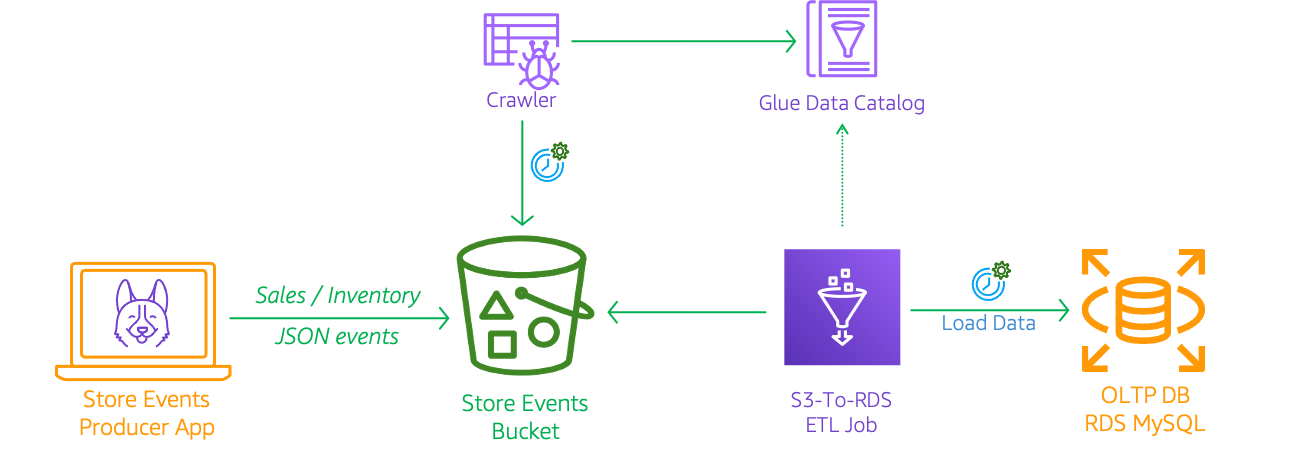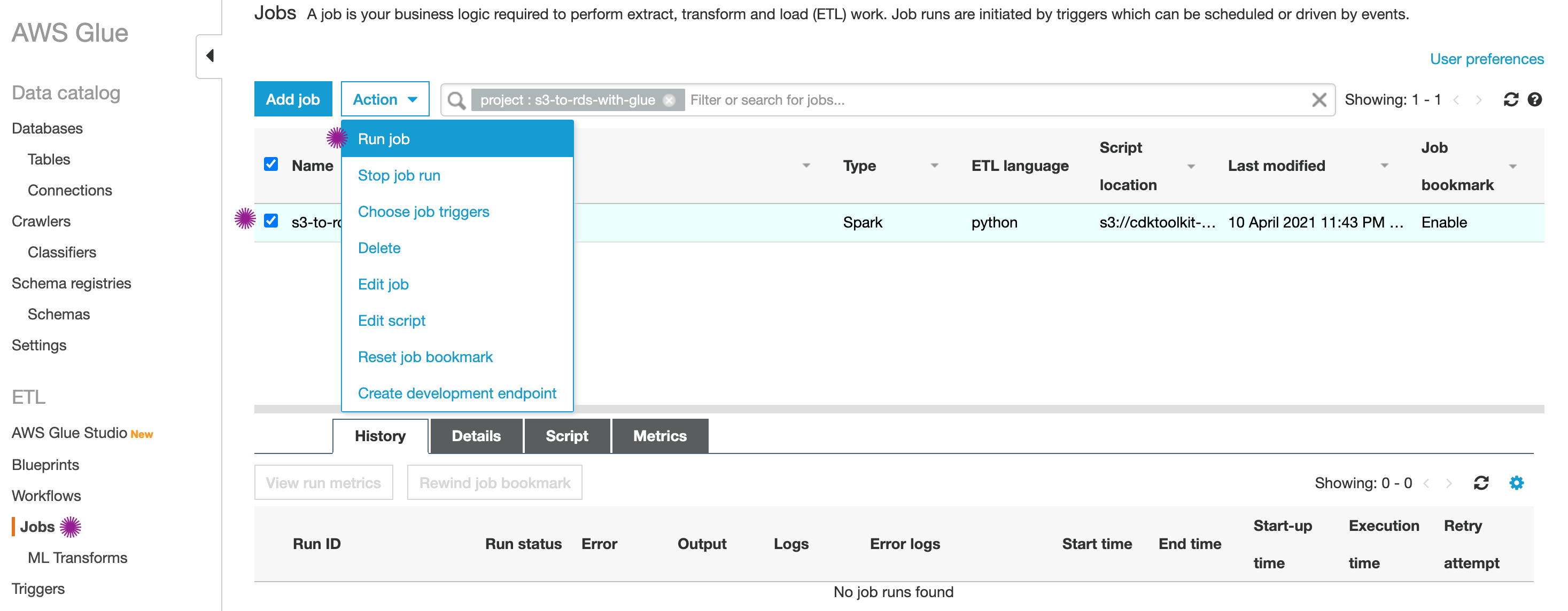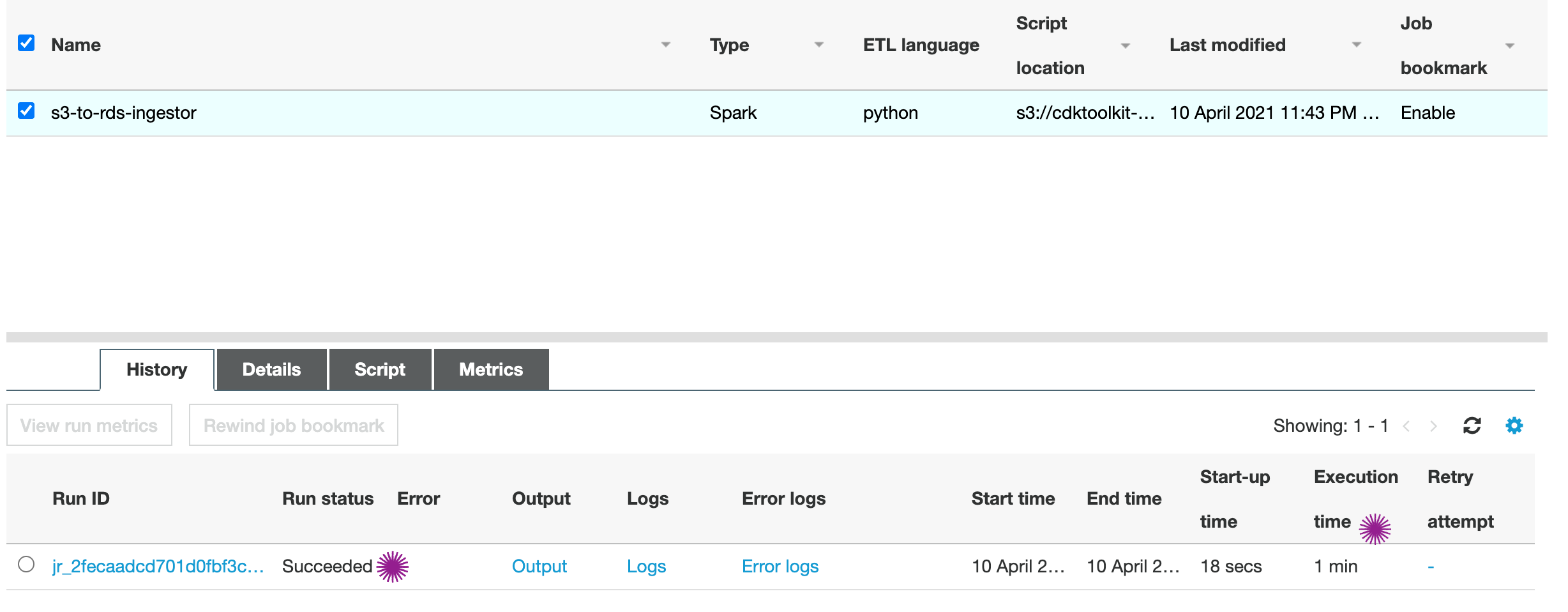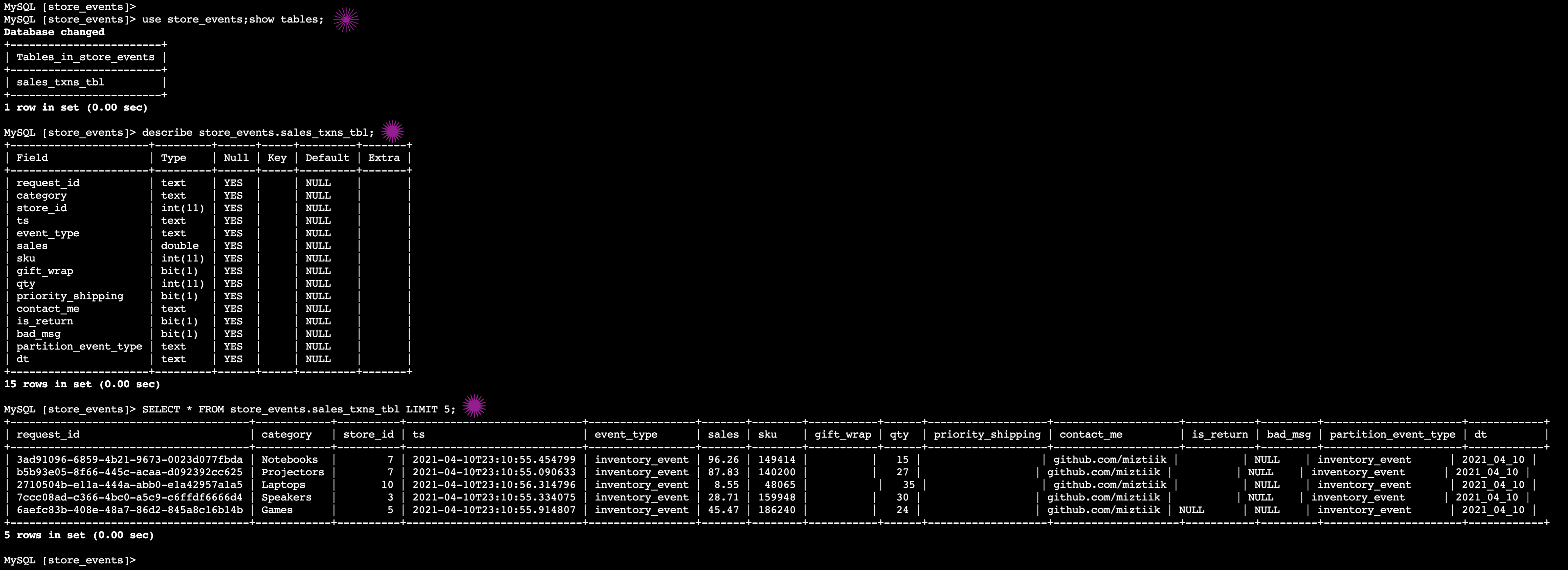The developers at Mystique Unicorn are exploring the option of building a OLTP 1 database in AWS using RDS. They have batches of JSON data arriving to their S3 bucket at frequent intervals. They would like a mechanism to ingest this data to RDS. New data is added to S3 on a daily schedule. This mechanism should be able to perform the data load incrementally.
Can you help them to process incoming events and process the incoming events from JSON format to parquet and store them in S3 to allow them to query with Athena.
AWS Glue is a fully managed serverless data integration service that makes it easy to extract, transform, and load (ETL) from various data sources for analytics and data processing with Apache Spark ETL jobs. In this application, we will fetch the incoming events from S3(generated by lambda) and process them using Glue Jobs and load them to RDS database for analytics. Let us assume each store produces an event like the one shown below,
{
"request_id": "ced29fc0-860b-4c41-a661-bef4ffd158ee",
"category": "Groceries",
"store_id": 3,
"ts": "2021-04-10T22:38:35.380361",
"event_type": "inventory_event",
"sales": 20.94,
"sku": 31555,
"gift_wrap": true,
"qty": 38,
"priority_shipping": true,
"contact_me": "github.com/miztiik",
"is_return": true
}-
This demo, instructions, scripts and cloudformation template is designed to be run in
us-east-1. With few modifications you can try it out in other regions as well(Not covered here).- 🛠 AWS CLI Installed & Configured - Get help here
- 🛠 AWS CDK Installed & Configured - Get help here
- 🛠 Python Packages, Change the below commands to suit your OS, the following is written for amzn linux 2
- Python3 -
yum install -y python3 - Python Pip -
yum install -y python-pip - Virtualenv -
pip3 install virtualenv
- Python3 -
-
-
Get the application code
git clone https://github.com/miztiik/s3-to-rds-with-glue cd s3-to-rds-with-glue
-
-
We will use
cdkto make our deployments easier. Lets go ahead and install the necessary components.# You should have npm pre-installed # If you DONT have cdk installed npm install -g aws-cdk # Make sure you in root directory python3 -m venv .venv source .venv/bin/activate pip3 install -r requirements.txt
The very first time you deploy an AWS CDK app into an environment (account/region), you’ll need to install a
bootstrap stack, Otherwise just go ahead and deploy usingcdk deploy.cdk bootstrap cdk ls # Follow on screen promptsYou should see an output of the available stacks,
sales-events-bkt-stack sales-events-producer-stack s3-to-rds-with-glue-vpc-stack oltp-consumer-on-ec2-stack sales-events-oltp-db-stack s3-to-rds-with-glue-txns-tbl-stack s3-to-rds-with-glue-crawler-stack s3-to-rds-with-glue-job-stack
-
Let us walk through each of the stacks,
-
Stack: sales-events-bkt-stack
This stack will create a version controlled s3 bucket to hold all our store events.
Initiate the deployment with the following command,
cdk deploy sales-events-bkt-stack
After successfully deploying the stack, Check the
Outputssection of the stack. You will find theStoreEventsBucket. -
Stack: sales-events-producer-stack
This stack will create the lambda function that will generate the events and write them to
StoreEventsBucketunder two prefixessale_eventsandinventory_events. The lambda function has a runtime of2seconds. If you want more events to be generated, then you can increase the duration of lambda and also run it multiple times.Initiate the deployment with the following command,
cdk deploy sales-events-producer-stack
After successfully deploying the stack, Check the
Outputssection of the stack. You will find the producerStoreOrdersEventsProducerlambda function. We will invoke this function later during our testing phase. -
Stack: oltp-consumer-on-ec2-stack
To simulate the access of business analysts to RDS, We will use an ec2 instance. This stack will also create the vpc, subnets, route tables using the stack
s3-to-rds-with-glue-vpc-stack. We will be using the same VPC for hosting our RDS OLTP server.The EC2 instance will be launched in the public subnet along with a IAM Role that supports SSM Session Manager access2. This Ec2 instance is configured to be bootstrapped with mysql client libraries to enable connections to RDS. Take a look at the userdata scripts at
stacks/back_end/oltp_consumer_on_ec2_stack/bootstrap_scripts/deploy_app.shif you want to modify them or improve them to add your own libraries.Initiate the deployment with the following command,
cdk deploy s3-to-rds-with-glue-vpc-stack cdk deploy oltp-consumer-on-ec2-stack
After successfully deploying the stack, Check the
Outputssection of the stack. You will find the instanceEc2ConsumerInstance. -
Stack: store-events-oltp-db-stack
To receive the incoming events from S3, we will need a OLTP database. We will use an RDS database running MySQL engine for that. This instance will be hosted in the private subnet and the security group is configured to allow port
3306connections from within the VPC. To enable AWS Glue to communicate between its components, a security group rule with a self-referencing inbound rule for all TCP ports is required3. The database is has the following configurations,- Database Name:
store_events - DB Engine Version:
5.7.xNative Glue Connections drivers for MySQL>8.xseem to be buggy at this moment, hence the lower version. - DB Username:
mystiquemaster - DB Password: Auto generated and stored in AWS Secrets Manager
- Parameter & Option Group: Defaults
Initiate the deployment with the following command,
cdk deploy store-events-oltp-db-stack
After successfully deploying the stack, Check the
Outputssection of the stack. You will find the DB ResourceStoreEventsDatabase. You will find the credentials to connect to the database in secrets manager arnStoreEventsDatabaseSecretArn. The sample command to connect to the db a cli can also be found there. - Database Name:
-
Stack: s3-to-rds-with-glue-txns-tbl-stack
This stack will create the Glue Catalog Database:
miztiik_sales_db. We will use a glue crawler to create a table under this database with metadata about the store events. We will hook up this table as data source for our glue jobs later.NOTE: This stack also create a table in glue database, we can ignore that for now. It is not used anywhere, It is a remanent and needs to be cleaned up.
Initiate the deployment with the following command,
cdk deploy s3-to-rds-with-glue-txns-tbl-stack
After successfully deploying the stack, Check the
Outputssection of the stack. You will find theGlueCatalogDBForStoreEventsresource. -
Stack: s3-to-rds-with-glue-crawler-stack
To ingest our S3 data to RDS, we need to know what columns are to be create and what are their types. We will use a crawler to populate our
StreamingETLGlueJobData Catalog with the discovered schema. Upon completion, the crawler creates or updates one or more tables in our data catalog. The crawler will also configured to be run on a periodic schedule to discover new data being added at our source.Remember the prefixes
sale_eventsandinventory_eventscreated by oursales-events-producer-stack, this will come in handy when we set our crawler to crawl these sources. If you decide to use Parquet or Athena you can use them to narrow down your query.We will also configure our crawler to exclude the prefix
bookmarks/**, As we will configure Glue Job Bookmarks4 to use this location to keep track of data being processed.The crawled data is added under a new table with the prefix
txns_under our glue database that we created within ours3-to-rds-with-glue-txns-tbl-stackInitiate the deployment with the following command,
cdk deploy s3-to-rds-with-glue-crawler-stack
After successfully deploying the stack, Check the
Outputssection of the stack. You will find theSaleTransactionsCrawlerresource. Although there is a trigger scheduled, We will later trigger this manually to quicken the testing process. -
Stack: s3-to-rds-with-glue-job-stack
All the stacks that we have deployed so far to get all prerequisites ready for data load to RDS. This stack will consum inputs from these stacsk and does ingestion of data from S3 to RDS. We need to supply a script that does the data ingestion to JDBC Datastore. As I am not much familiar with Spark scripts, I used the Glue console to generate the script for me. The code is provided to you in this location
stacks/back_end/glue_stacks/glue_job_scripts/load_json_to_rds.py.To connect to our RDS/JDBC data store, we need a Glue connection5 that stores connection information like login credentials, URI strings, virtual private cloud (VPC) information, and etc. At the moment of writing this demo, there is no easy way to securely provide the database password in clouformation while create a glue connection. To avoid hardcoding db password in Cfn, I have decided to provision it with a dummy password. Later we will update it from the console, you can also do the same with Cfn Custom Resource/CLI/SDK etc. No easy way out here
I have parameterized the script so that we can pass in the database, table and bucket name as glue job parameters. Notice the secret arn, we will use the Glue Job environment to safely access the credentials from secrets manager.
src_db_name: This will be ourGlueCatalogDBForStoreEventssrc_etl_bkt: This will be ourStoreEventsBucketcrawler_tbl_prefix: This will betxns_tgt_db_secret_arn: This will beStoreEventsDatabaseSecretArntgt_tbl_name: At this moment, we will use the same name as our crawler create table name.conn_name: The Glue connection for MySQL5.7 will be created by the stack and passed on as a parameter. Remember the caveat, about RDS versions when deploying OLTP DB stack
As this will be doing very small batch uploads, the Glue job
timeoutis set for 2 minutes. We will also set up job to consume2 DPU. As a learning attempt on how to setup job triggers, I have also set up the job to be triggered to every day at 1 in the morning. Job bookmarks will persist heres3://<StoreEventsBucketName>/bookmarks.Initiate the deployment with the following command,
cdk deploy s3-to-rds-with-glue-job-stack
After successfully deploying the stack, Check the
Outputssection of the stack. You will find theRDSIngestorETLGlueJobGlue Job.
-
-
-
Invoke Producer Lambda: Let us start by invoking the lambda
StoreOrdersEventsProducerfrom the producer stack using the AWS Console. If you want to ingest more events, invoke the lambda few times.{ "statusCode": 200, "body": "{\"message\": {\"status\": true, \"tot_msgs\": 28, \"bad_msgs\": 2, \"sale_evnts\": 14, \"inventory_evnts\": 14, \"tot_sales\": 1303.87}}" }Here in this invocation, We have generated
28messages. Within those message, we have14sale events and14are created.At this point, we have events coming from our producers being stored in S3. These events will be crawled by glue update our catalog.
-
Invoke Glue Crawler:
Access AWS Glue Crawler from the console, You should be able to find
sale_txns_crawler. Trigger the crawler
After the crawler has successfully completed, if you navigate to the Glue Database > Tables, You will find our discovered schema along with our partitions.
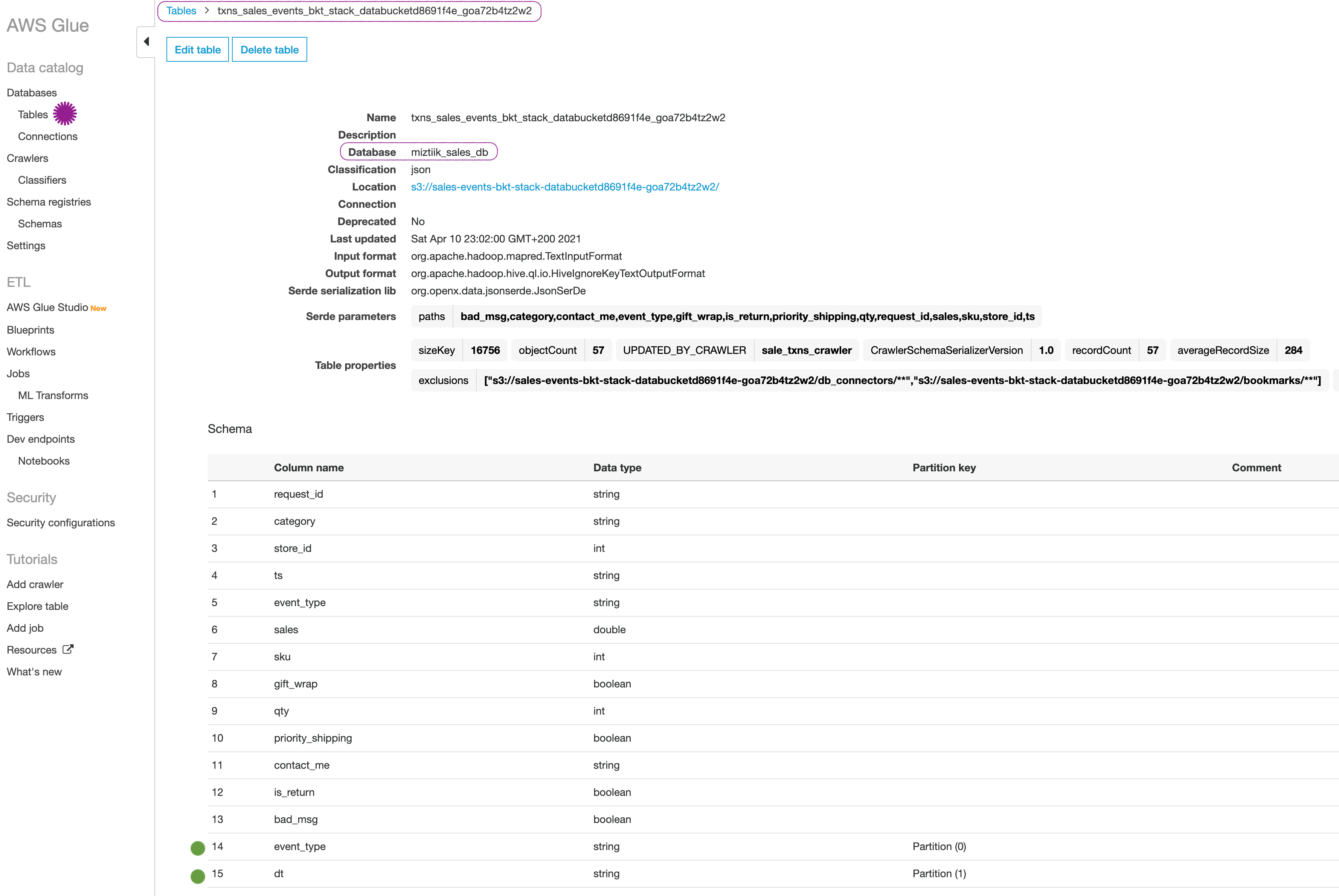
-
Configure Glue Connection: We will now replace the dummy password in glue connection with the actual one from Secrets Manager.
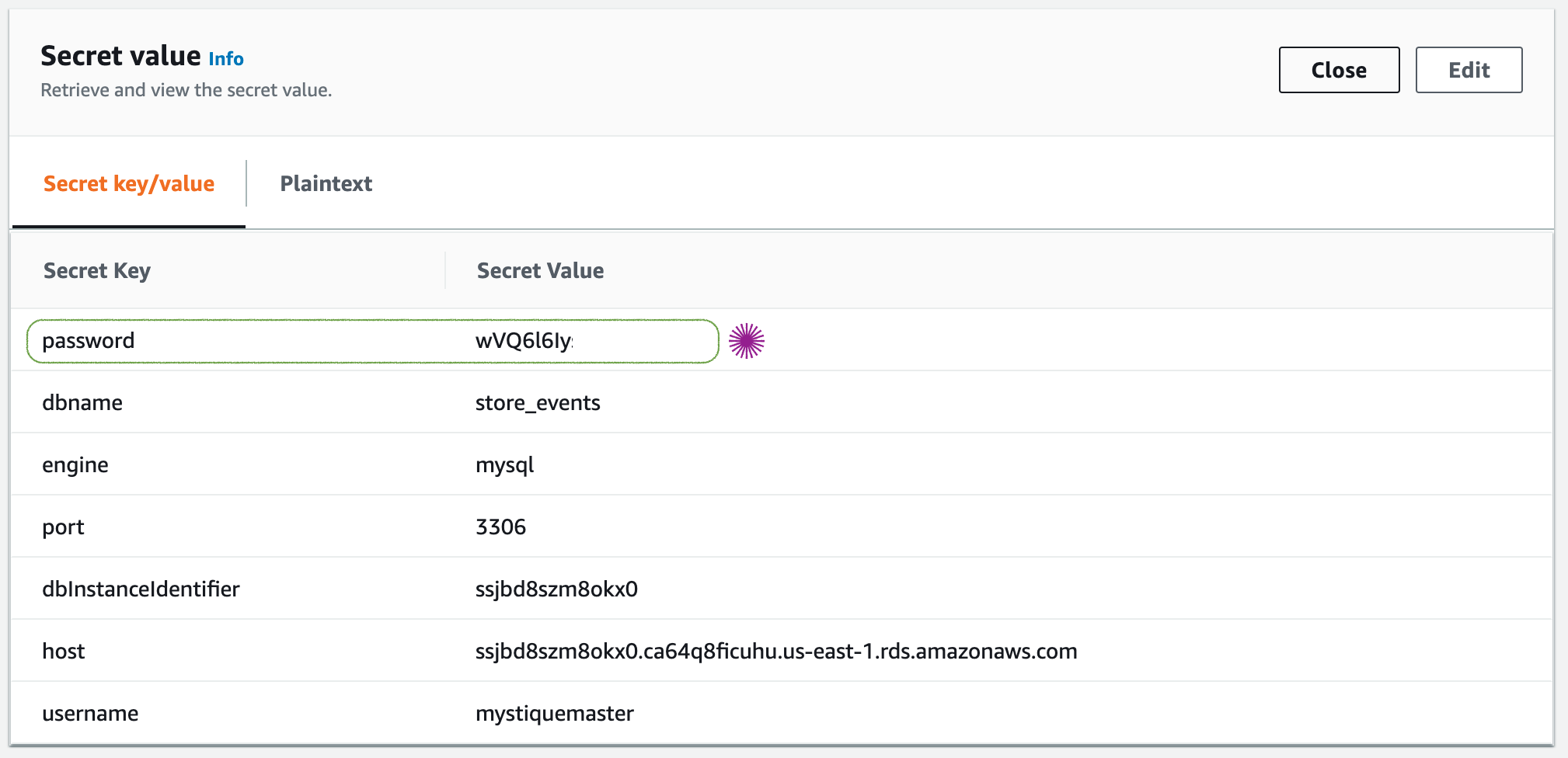
In AWS Glue > Connections >
rdsMySQL57Conn> Edit > Next > Update Password > Next > Finish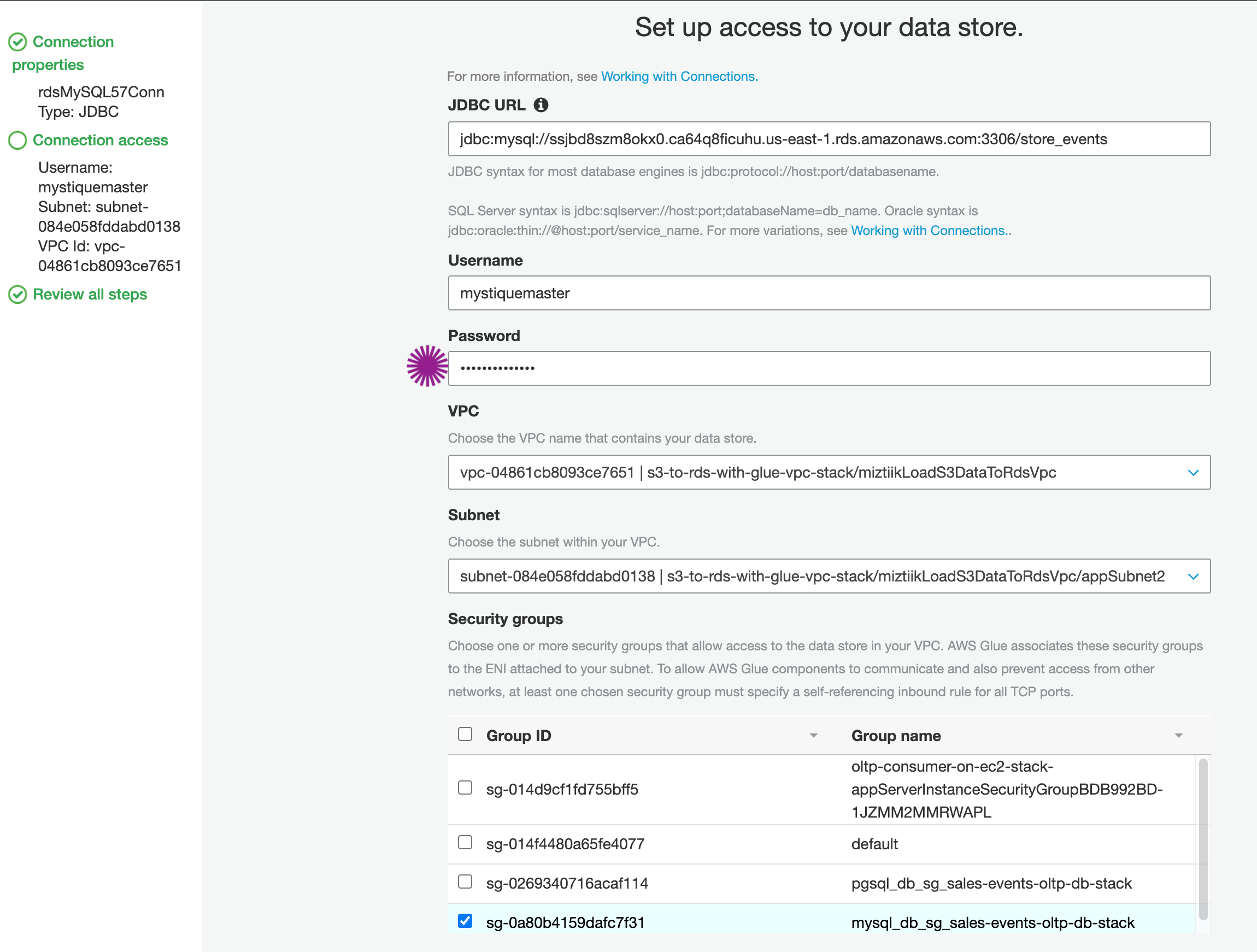
-
Connect To OLTP consumer ON EC2: Connect to the
Ec2ConsumerInstanceinstance using SSM Session Manager2.mysql -h ssjbd8szm8okx0.ca64q8ficuhu.us-east-1.rds.amazonaws.com -u mystiquemaster -P 3306 -p # Provide password from Secrets Manager use store_events;show tables;
You can see that there are no tables under our database
store_events. -
Invoke Glue Job:
Navigate to the Glue Job Console and you should find a job
s3-to-rds-ingestor. Run the job from the actions menu. You do not have to change any parameters as they are all pre-configured.After about a minute or so, the job should complete successfully. You can check the logs in cloudwatch, if needed.
Let us go back to our OLTP Consumer on EC2 and check the database again,
use store_events;show tables; SELECT COUNT(*) FROM store_events.sales_txns_tbl; SELECT * FROM store_events.sales_txns_tbl LIMIT 5; DESCRIBE store_events.sales_txns_tbl;
You can observe that there are
28records here, same the entries generated byStoreOrdersEventsProducer. You can do an incremental load, by triggering the lambda followed by running the Glue Job again. You will find only the new records being added to the database. -
Check S3 Bucket:
Check the s3 bucket
StoreEventsBucketfor the job bookmarks under prefixbookmarks/.You can use S3 Select to view the contents and able to understand how many files were processed in the previous run.
-
-
Here we have demonstrated how to use Glue to load data from S3 to RDS using crawlers and spark jobs. You can extend this further by transforming the data before loading RDS.
-
If you want to destroy all the resources created by the stack, Execute the below command to delete the stack, or you can delete the stack from console as well
- Resources created during Deploying The Application
- Delete CloudWatch Lambda LogGroups
- Any other custom resources, you have created for this demo
# Delete from cdk cdk destroy # Follow any on-screen prompts # Delete the CF Stack, If you used cloudformation to deploy the stack. aws cloudformation delete-stack \ --stack-name "MiztiikAutomationStack" \ --region "${AWS_REGION}"
This is not an exhaustive list, please carry out other necessary steps as maybe applicable to your needs.
This repository aims to show how to use AWS Glue for ETL processing architecture to new developers, Solution Architects & Ops Engineers in AWS. Based on that knowledge these Udemy course #1, course #2 helps you build complete architecture in AWS.
Thank you for your interest in contributing to our project. Whether it is a bug report, new feature, correction, or additional documentation or solutions, we greatly value feedback and contributions from our community. Start here

- Wiki: Online transaction processing
- AWS SSM Session Manager
- AWS Docs: Setting Up a VPC to Connect to JDBC Data Stores
- AWS Docs: Tracking Processed Data Using Job Bookmarks
- AWS Docs: AWS Glue Connections
Level: 300
